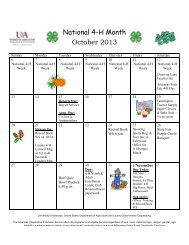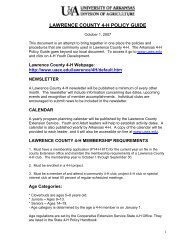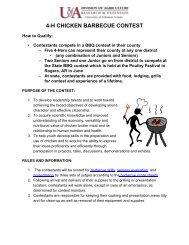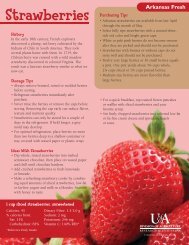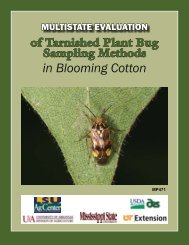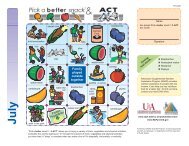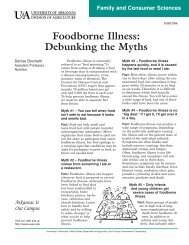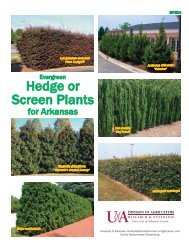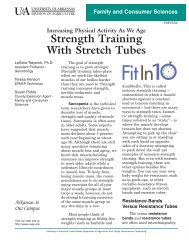The National 4-H Recognition Model - University of Arkansas ...
The National 4-H Recognition Model - University of Arkansas ...
The National 4-H Recognition Model - University of Arkansas ...
Create successful ePaper yourself
Turn your PDF publications into a flip-book with our unique Google optimized e-Paper software.
4-H Youth Development<br />
4HCL1<br />
4-H Volunteer Leaders’ Series<br />
<strong>The</strong> <strong>National</strong> 4-H <strong>Recognition</strong> <strong>Model</strong><br />
Mike Klumpp<br />
Associate Pr<strong>of</strong>essor -<br />
4-H Youth Development<br />
*18 USC 707<br />
Visit our web site at:<br />
http://www.uaex.edu<br />
Why <strong>Recognition</strong>?<br />
<strong>Recognition</strong> is not a separate,<br />
unrelated part <strong>of</strong> 4-H. It should be an<br />
integral part <strong>of</strong> all 4-H educational<br />
experiences. <strong>The</strong> <strong>National</strong> 4-H <strong>Recognition</strong><br />
<strong>Model</strong> provides a framework for<br />
meeting the challenge <strong>of</strong> recognizing<br />
young people in 4-H. Because we work<br />
with a variety <strong>of</strong> young people in<br />
many different learning situations, we<br />
cannot expect one type <strong>of</strong> recognition<br />
to work in all situations.<br />
<strong>The</strong> <strong>Model</strong><br />
<strong>The</strong> <strong>National</strong> 4-H <strong>Recognition</strong><br />
<strong>Model</strong> uses five approaches:<br />
1. Participation – Simple requirements,<br />
well publicized, can be<br />
earned many times, is presented<br />
at the activity, is appropriate for<br />
activity and 4-H’er, and need not<br />
be expensive but is valued by<br />
the 4-H’er.<br />
2. Progress Toward Self-Set<br />
Goals – For all ages and activities,<br />
realistic and reachable, uses<br />
4-H’er’s own goals and plans,<br />
evaluated by 4-H’er and adults,<br />
and is measured against goals.<br />
3. Achievement <strong>of</strong> Standards –<br />
Established by specialists, clearly<br />
defined and not changed, uses<br />
rating categories (Blue, Red,<br />
White) and measures quality. <strong>The</strong><br />
Teen Star Award is one example.<br />
4. Peer Competition – High risk,<br />
makes competition optional, can<br />
confuse means and ends, needs<br />
rules and procedure, may generate<br />
publicity and is not for children<br />
under the age <strong>of</strong> nine.<br />
5. Excellence in Cooperation –<br />
Uses mutually agreed upon goals,<br />
gives attention to way group<br />
works, ultimate goal is not<br />
recognition and recognizes all.<br />
(Club Community Service Award)<br />
Beliefs About <strong>Recognition</strong><br />
4-H subscribes to some basic<br />
beliefs that make recognition an<br />
educational tool for developing life<br />
skills. <strong>The</strong>se are:<br />
●<br />
●<br />
●<br />
●<br />
●<br />
●<br />
●<br />
●<br />
Meets basic human need.<br />
Builds positive self-esteem.<br />
Balances extrinsic (tangible) and<br />
intrinsic (intangible).<br />
Part <strong>of</strong> all 4-H experiences.<br />
Appropriate recognition takes<br />
many forms.<br />
Requires adult support.<br />
All 4-H’ers need to be recognized<br />
at some time.<br />
Presented soon after earned and<br />
in front <strong>of</strong> significant others.<br />
<strong>University</strong> <strong>of</strong> <strong>Arkansas</strong>, United States Department <strong>of</strong> Agriculture, and County Governments Cooperating
●<br />
●<br />
Appropriate recognition for individual 4-H’ers<br />
varies with their stage <strong>of</strong> development, past<br />
experiences, family lifestyle, community and<br />
cultural heritage.<br />
Includes self-assessment and reflection.<br />
●<br />
Select awards appropriate for the age <strong>of</strong> your<br />
members. <strong>The</strong> award should be something that<br />
age group values. For example, 9- to 11-year-olds<br />
like to collect things, so ribbons, buttons, etc., are<br />
valued. Teens appreciate things they can use –<br />
cash, sweatshirts, etc.<br />
●<br />
Gives choices to 4-H’ers in learning and<br />
participation.<br />
●<br />
Select awards related to the learning experience;<br />
remember, they do not need to be expensive.<br />
●<br />
Balance is needed among all element <strong>of</strong> the model<br />
for 4-H programs at all levels.<br />
Making it Work<br />
As a 4-H volunteer, your challenge is to help<br />
young people become self-directed, productive and<br />
contributing citizens. <strong>Recognition</strong> is one <strong>of</strong> the ways<br />
you can achieve this goal. Although we regularly use<br />
recognition, we need to continually review our efforts<br />
to see if we are at our desired goals.<br />
Selection <strong>of</strong> Awards<br />
When you select awards, here are some ideas to<br />
consider:<br />
●<br />
●<br />
●<br />
●<br />
Use the 4-H name and emblem, whenever<br />
possible. <strong>The</strong> use <strong>of</strong> the 4-H group’s name or<br />
county name is always appropriate. Using the<br />
<strong>University</strong> <strong>of</strong> <strong>Arkansas</strong> Division <strong>of</strong> Agriculture,<br />
Cooperative Extension logo will add prestige to<br />
the award.<br />
Select awards that are distinctive and show good<br />
design principles.<br />
Avoid using the same award repeatedly for the<br />
same program or different program.<br />
Remember, news media reports (newspaper,<br />
radio, etc.) enhance any award.<br />
Acknowledgment is given to the original author, Dr. Darlene Z. Millard, assistant director - 4-H youth<br />
development.<br />
Reference: <strong>Recognition</strong> Handbook: Guide for Facilitators, produced by CSREES/USDA and <strong>National</strong> 4-H<br />
Council, 1996.<br />
Printed by <strong>University</strong> <strong>of</strong> <strong>Arkansas</strong> Cooperative Extension Service Printing Services.<br />
MIKE KLUMPP is associate pr<strong>of</strong>essor - 4-H youth development, Issued in furtherance <strong>of</strong> Cooperative Extension work, Acts <strong>of</strong> May 8<br />
<strong>University</strong> <strong>of</strong> <strong>Arkansas</strong> Division <strong>of</strong> Agriculture, Cooperative Extension and June 30, 1914, in cooperation with the U.S. Department <strong>of</strong><br />
Service, Little Rock.<br />
Agriculture, Director, Cooperative Extension Service, <strong>University</strong> <strong>of</strong><br />
<strong>Arkansas</strong>. <strong>The</strong> <strong>Arkansas</strong> Cooperative Extension Service <strong>of</strong>fers its<br />
programs to all eligible persons regardless <strong>of</strong> race, color, national<br />
origin, religion, gender, age, disability, marital or veteran status,<br />
or any other legally protected status, and is an Affirmative<br />
4HCL1-PD-1-09RV Action/Equal Opportunity Employer.




